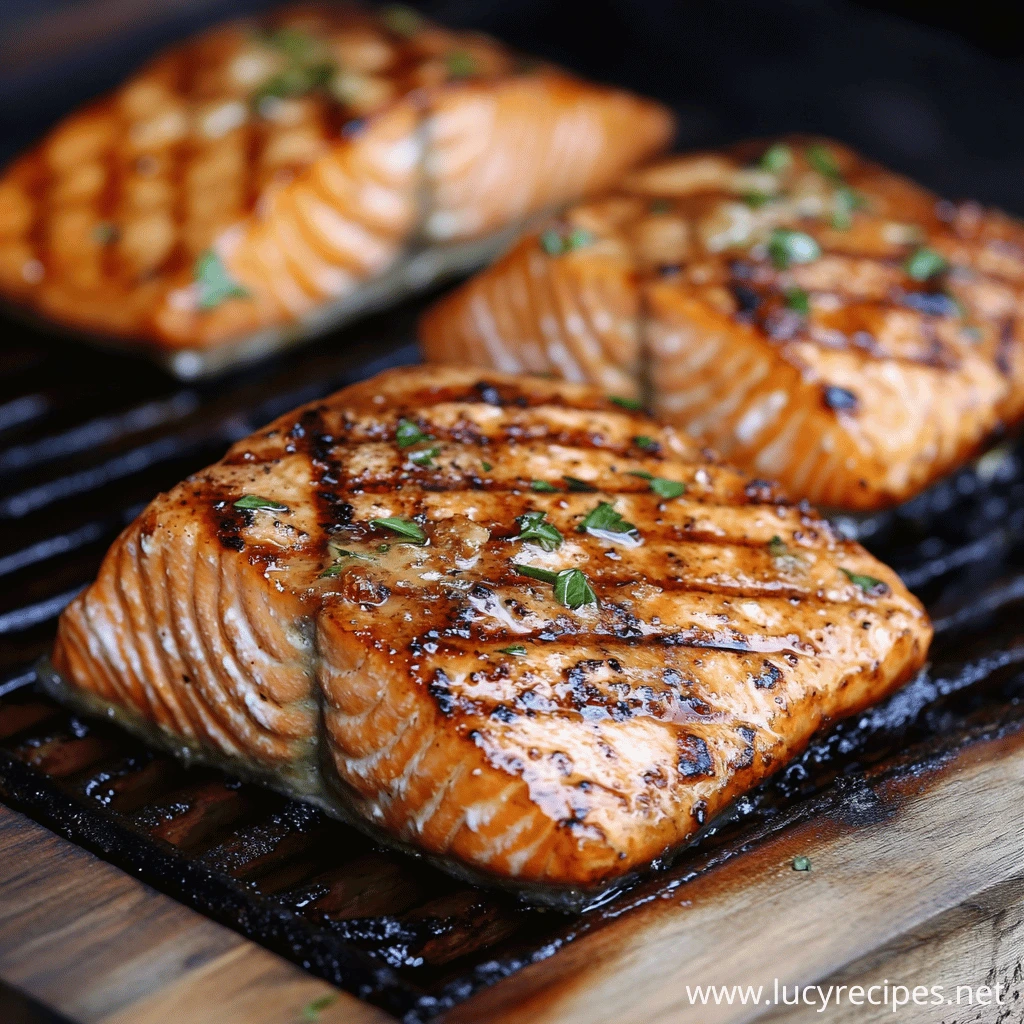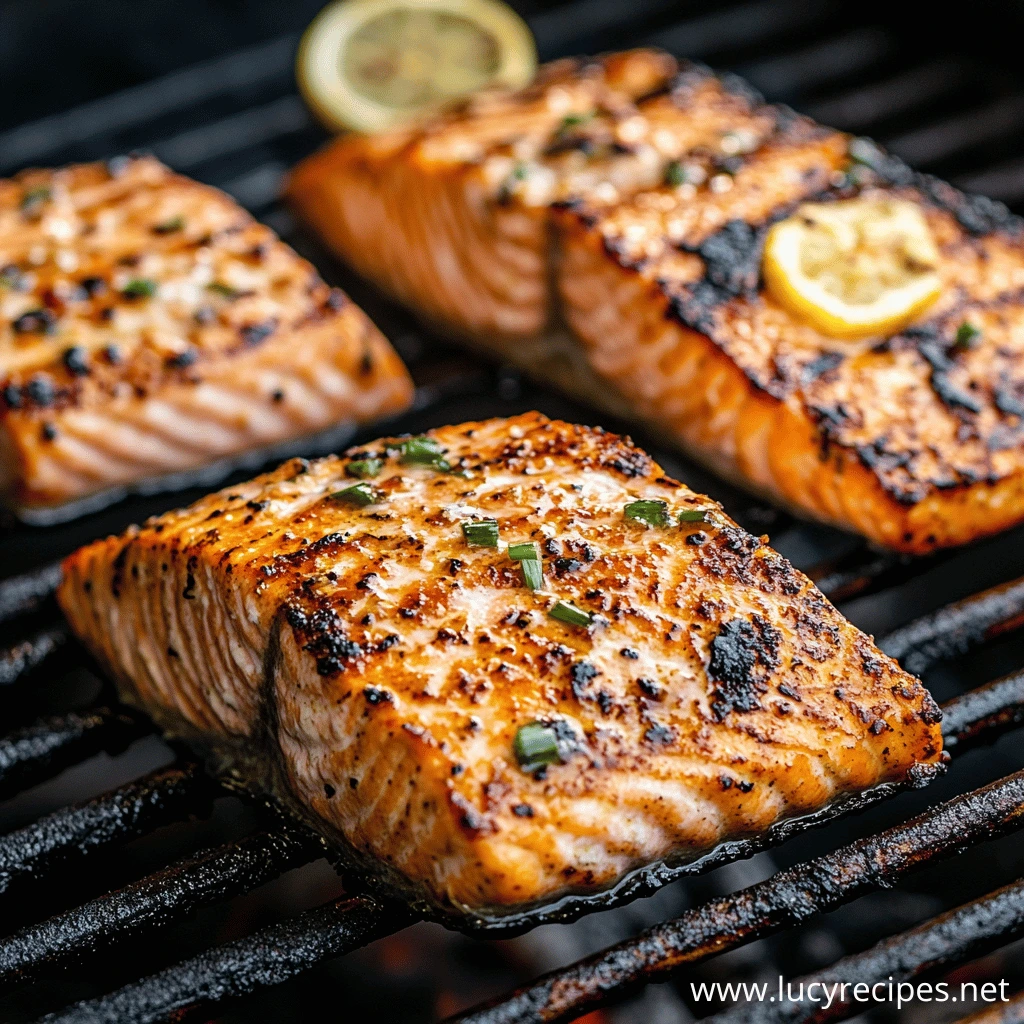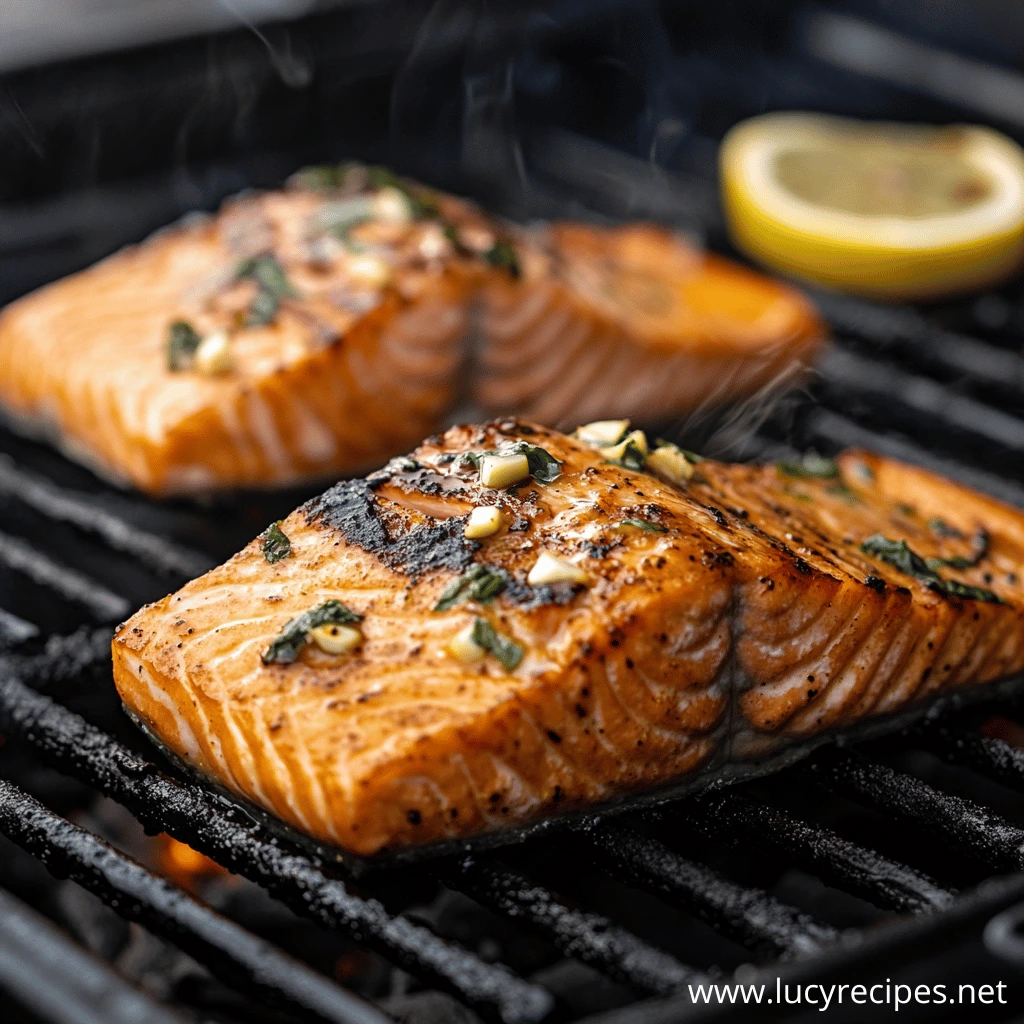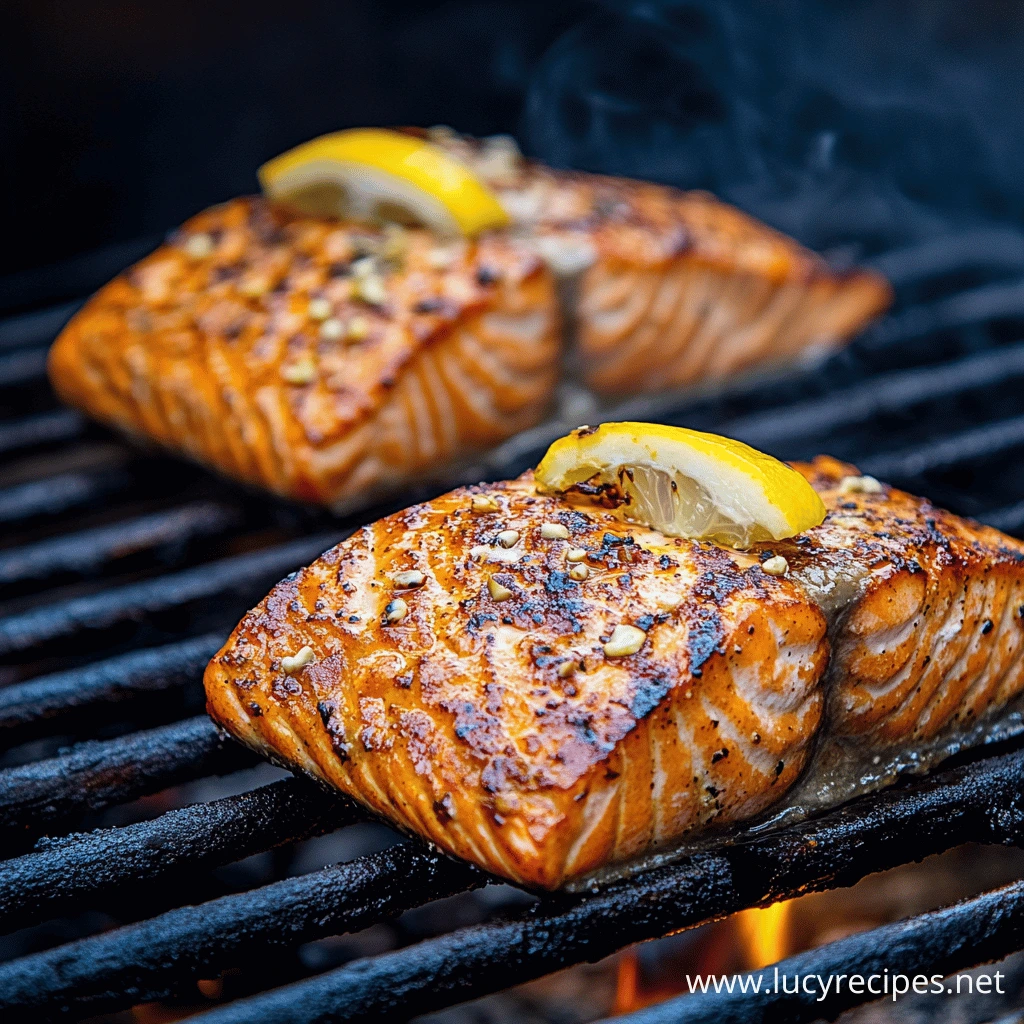Introduction
Grilling salmon is a culinary art that brings out its natural flavors while adding a smoky, charred touch. Whether you are a seasoned griller or a beginner, mastering the techniques for grilling salmon can elevate your cooking game. A common question often arises: Do you flip salmon on the grill? This guide will answer this and other key questions to ensure your grilled salmon is nothing short of perfection.
Table of Contents
Understanding the Basics of Grilling Salmon
Grilling salmon requires a balance of heat, timing, and preparation (For insights into alternative techniques, such as cooking salmon in foil, you can refer to foil grill salmon). Unlike other proteins, salmon is delicate and prone to sticking or falling apart if mishandled. To ensure success:
- Start with fresh, high-quality salmon.
- Choose between skin-on or skinless fillets depending on your preference.
- Prepare the grill adequately to avoid sticking.
Understanding these basics ensures your salmon remains flavorful, tender, and intact throughout the grilling process. Additionally, knowing how to control your grill’s temperature and using the right tools can make a significant difference.
Grilling is as much about preparation as it is about execution. Cleaning the grates, oiling them lightly, and preheating the grill help create a non-stick surface, reducing the risk of your salmon tearing apart. Proper preparation also minimizes the chances of uneven cooking or burning, which are common challenges when grilling delicate fish like salmon.
Benefits of Grilling Salmon: A Healthy and Flavorful Option
Do You Flip Salmon On The Grill? Grilled salmon is not only a flavorful treat but also a nutritional powerhouse. Packed with omega-3 fatty acids, vitamins, and protein, salmon supports heart health and enhances brain function. Grilling is an excellent cooking method that offers several benefits:
- It preserves the natural oils and nutrients of salmon.
- Requires little to no added fat, making it a healthier option.
- Adds a smoky flavor that elevates its natural taste.
When preparing grilled salmon, a common question arises: Do you flip salmon on the grill? While flipping is optional, it can help ensure even cooking and those beautiful grill marks. Including salmon in your meals provides a nutrient-rich, satisfying experience. Compared to other proteins, salmon uniquely combines exceptional taste with health benefits. Grilling enhances these qualities by sealing in the juices and reducing the need for heavy sauces. The smoky aroma from grilling further elevates its flavor, making it a standout dish for any occasion.
Learn more about specific grilling times for salmon in the helpful guide on how long to grill 1-inch salmon.
Prepping Your Salmon for the Grill: Essential Tips
Preparation is key when grilling salmon. Properly prepped salmon ensures even cooking and prevents sticking. Here’s what to do:
- Clean and pat dry: Remove moisture for a better sear.
- Season appropriately: Use salt, pepper, and a light coat of olive oil.
- Marinate wisely: Avoid over-marinating to prevent overpowering the salmon’s natural flavor.
- Debone carefully: Remove pin bones using kitchen tweezers for a pleasant dining experience.
These steps are vital for creating a foundation for grilling success. Additionally, if you’re using frozen salmon, ensure it is fully thawed before cooking to guarantee even heat distribution. Preparing the salmon properly also enhances its ability to absorb marinades and seasonings, making every bite more flavorful.
Choosing the Right Tools for Grilling Salmon
The right tools make grilling salmon easier and more efficient. Equip yourself with:
- A high-quality grill (gas, charcoal, or electric).
- A grill brush for cleaning grates.
- Long-handled tongs and a wide spatula for safe handling.
- Non-stick spray or a fish grilling basket to prevent sticking.
Investing in these tools minimizes frustration and enhances your grilling experience. For beginners, a grilling basket can simplify the process and reduce the risk of breakage, particularly when flipping. A reliable thermometer can also help you monitor the internal temperature, ensuring perfectly cooked salmon every time.
Should You Flip Salmon on the Grill? Key Considerations

Do you flip salmon on the grill? This is a question that divides many cooks. Flipping salmon is not always necessary, especially if you’re using indirect heat or alternative methods like cedar planks. However, when grilling directly, flipping can:
- Ensure even cooking.
- Promote attractive grill marks.
- Help release the salmon from the grates when timed correctly.
Understanding the type of grill and method you’re using determines whether flipping is required. For instance, skin-on salmon is more forgiving and easier to flip than skinless fillets. The decision to flip or not also depends on the cooking style, desired presentation, and personal preference.
For a simplified approach, consider using foil methods as detailed in foil grill salmon.
Best Practices for Flipping Salmon: Timing and Techniques
When flipping salmon on the grill, proper timing and technique are essential to prevent sticking and breakage. Follow these guidelines:
- Wait until the salmon easily releases from the grill before flipping (usually 4-6 minutes).
- Use a wide spatula for support.
- Flip gently and only once to avoid overhandling.
These practices ensure your salmon retains its shape and texture. Additionally, maintaining consistent heat levels on the grill helps prevent the salmon from sticking or burning. Timing is everything; flipping too early can cause the salmon to stick, while waiting too long may overcook one side.
Skin-On vs. Skinless Salmon: Which Works Better for Grilling?
Choosing between skin-on and skinless salmon impacts your grilling approach. Here’s how:
- Skin-on salmon: Acts as a natural barrier, preventing sticking and adding crispiness.
- Skinless salmon: Ideal for those who prefer not to eat the skin but requires careful handling to avoid breakage.
For beginners, skin-on salmon is generally easier to manage and produces consistent results. The skin also locks in moisture and flavor, making it a popular choice among grilling enthusiasts. However, skinless salmon offers more versatility for certain recipes, such as grilled salmon salads or wraps.
The Perfect Grill Setup for Cooking Salmon
A well-prepared grill ensures even cooking and minimizes sticking. To set up your grill:
- Preheat to medium-high heat (about 375-400°F).
- Clean the grates thoroughly.
- Oil the grates lightly with a paper towel dipped in cooking oil.
- Arrange salmon on the grill away from direct flames if using a charcoal grill.
This setup creates an optimal cooking environment for salmon. Using a dual-zone grilling method (direct and indirect heat zones) offers greater flexibility, particularly for thicker cuts. Proper grill setup also helps you avoid flare-ups, which can scorch the salmon and disrupt cooking.
Common Mistakes to Avoid When Grilling Salmon
Avoiding common pitfalls ensures a smoother grilling experience. Some mistakes to watch for include:
- Overcooking: Leads to dry, tough salmon.
- Underseasoning: Results in bland flavors.
- Using high heat: Causes burning without cooking through.
- Improper flipping: Can result in breakage.
By steering clear of these errors, you’ll achieve perfectly grilled salmon every time. Taking the time to monitor your grill temperature and use the right tools can make a significant difference. Avoiding these mistakes also enhances your confidence as a griller.
How to Achieve Perfect Grill Marks on Salmon

Grill marks not only look appealing but also indicate expert-level grilling. To create them:
- Preheat the grill and ensure the grates are clean.
- Place the salmon at a 45-degree angle to the grates.
- Avoid moving the salmon until it naturally releases.
- Rotate 90 degrees halfway through cooking for cross-hatch marks.
Mastering this technique elevates the presentation of your salmon. Remember that patience is key when achieving perfect grill marks without sticking. Consistent practice will help you develop the skills needed to replicate restaurant-quality results.
Direct Heat vs. Indirect Heat: What’s Best for Grilling Salmon?
Both direct and indirect heat methods work for grilling salmon, depending on the desired result:
- Direct heat: Ideal for quick cooking and searing.
- Indirect heat: Suitable for thicker cuts and prevents overcooking.
Experimenting with both techniques helps you find the perfect balance for your preferences. Using indirect heat is particularly beneficial when grilling whole salmon or large fillets. Combining the two methods can also yield excellent results, with direct heat for initial searing and indirect heat for thorough cooking.
Marinating Salmon: When and How to Add Flavor
Marination enhances the flavor of salmon but must be done correctly. Keep these tips in mind:
- Marinate for 15-30 minutes to avoid overpowering the fish.
- Use acidic ingredients like lemon juice sparingly to prevent breaking down the flesh.
- Apply the marinade evenly.
A thoughtful approach to marination complements the salmon’s natural taste. For an extra layer of flavor, brush the salmon with the marinade during the last few minutes of grilling. Experimenting with different marinades can help you discover new flavor profiles, from Asian-inspired soy and ginger blends to Mediterranean herb infusions.
Troubleshooting Common Grilling Issues with Salmon
Even experienced grillers encounter challenges. Here are solutions to common issues:
- Sticking: Ensure grates are clean and well-oiled.
- Uneven cooking: Adjust the placement of the salmon on the grill.
- Breakage: Flip carefully using a wide spatula.
Addressing these problems promptly keeps your grilling experience stress-free. Additionally, using a fish grilling basket can simplify the process and reduce common errors. Paying attention to these details ensures consistent results every time.
Alternatives to Flipping Salmon: Cedar Plank and Foil Methods

If you’re hesitant to flip salmon, consider alternative methods like:
- Cedar planks: Add a smoky flavor and prevent direct contact with the grill.
- Foil packets: Lock in moisture and flavors while simplifying cleanup.
Both methods eliminate the need for flipping while delivering delicious results. Cedar planks, in particular, impart a unique aroma that enhances the overall dining experience. Foil packets are versatile and work well for adding vegetables or sauces alongside the salmon.
Complementary Side Dishes and Sauces for Grilled Salmon
Pairing grilled salmon with the right sides and sauces enhances the meal. Popular options include:
- Side dishes:
- Grilled vegetables
- Quinoa or rice
- Mixed green salads
- Sauces:
- Lemon-dill yogurt sauce
- Teriyaki glaze
- Mango salsa
These accompaniments provide a balanced and flavorful dining experience. Adding a fresh herb garnish can further elevate the presentation and taste. Choosing complementary sides enhances the overall appeal of your meal.
Explore recipes like old-fashioned sweet potato casserole or mini pecan tarts for delicious accompaniments.
FAQs
Do you flip salmon on the grill?
Yes, flipping salmon is necessary in certain cases to ensure even cooking. However, alternative methods can eliminate this step.
How long should salmon cook on the grill?
Salmon typically takes 10-12 minutes to cook, depending on thickness and grill temperature.
Can you grill frozen salmon?
Yes, but it’s best to thaw it first for even cooking.
What’s the best type of salmon for grilling?
Atlantic and sockeye salmon are excellent choices due to their flavor and texture.
Conclusion
Grilling salmon is a rewarding culinary endeavor that combines simplicity and flavor. Whether you choose to flip it or opt for alternative methods, the key is preparation and attention to detail. By following this comprehensive guide, you’ll master the art of grilling salmon and impress your guests with every bite. With practice, you’ll gain confidence and creativity, transforming each meal into a memorable occasion. The knowledge and skills you develop will enable you to enjoy salmon at its finest, elevating your grilling repertoire to new heights.

